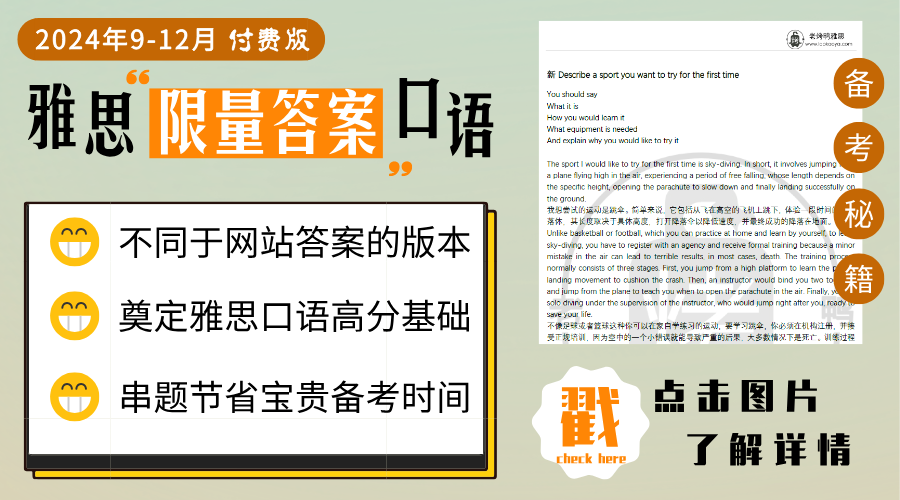剑桥雅思8Test2Section3听力原文与答案 Honey Bees in Australia
剑桥雅思8听力第二套题目第三部分的主题为澳大利亚防疫局如何保护本地的蜜蜂。文章内容包括亚洲蜜蜂的危害,澳大利亚蜜蜂的好处,以及如何寻找亚洲蜜蜂等。
易错点主要是第22题,一方面很多同学不熟悉mites和parasites的同义替换;另一方面录音中说的也比较绕一些。是亚洲蜜蜂身上携带的寄生虫会攻击澳大利亚蜜蜂。它们本身并不会这样做,因此排除A选B。
点击查看这篇雅思听力中需要大家掌握的重点词汇与具体题目的答案解析:
雅思备考听力篇 剑8 test 2 section 3 雅思听力高频词汇
剑桥雅思8Test2听力Section3答案解析 Honey Bees in Australia
剑8 test 2 Section 3雅思听力原文
PROFESSOR: Good morning everyone. In today’s seminar, Grant Freeman, a biologist who specialises in identifying insects, and who works for the Australian Quarantine Service, has come to talk to us about his current research work. Right, well, over to you, Grant.
GRANT: Good morning, everyone. I’m sure that you know that the quarantine service regulates all food brought into Australia. Well, obviously they want to protect Australia from diseases that might come in with imported goods, but they also want to prevent insect pests from being introduced into the country, and that’s where I have a part to play. Anyway, my current research involves trying to find a particular type of bee, the Asian Honey Bee, and finding out whether there are any of them around in various states of Australia. We discovered a few of them in Queensland (Q21) once and eradicated them. Now, we’re pretty keen to make sure that there aren’t any more getting in, particularly to New South Wales and other states.
STUDENT 1: What’s wrong with Asian Honey Bees? Are they so different from Australian bees?
GRANT: Well, in fact, they look almost the same, but they are infested with mites (Q22) – microscopic creatures which live on them, and which can seriously damage our own home-grown bees, or could even wipe them out.
PROFESSOR: Well, what would happen if Australian bees died out?
GRANT: Well, the honey from Australian bees is of excellent quality, much better than the stuff the Asian bees produce. In fact, Australia exports native Queen bees to a large number of countries because of this (Q23). When the European Honey Bee was first discovered out in the bush, we found they made really unpleasant honey and they were also too big to pollinate many of our native flowers here in Australia.
STUDENT 2: That must have had a devastating effect on the natural flora. Did you lose any species?
GRANT: NO, we managed to get them under control before that happened but if Asian bees got in there could be other consequences. We could lose a lot of money (Q24) because you might not be aware, but it’s estimated that native bees’ pollination of flower and vegetable crops is worth 1. 2 billion dollars a year. So in a way they’re the farmers’ friend. Oh, and another thing is, if you’re stung by an Asian Honey Bee, it can produce an allergic reaction in some people; so they’re much more dangerous than native bees.
PROFESSOR: HOW will you know if Asian bees have entered Australia?
GRANT: We’re looking at the diet of the bird called the Rainbow Bee Eater. The Bee Eater doesn’t care what it eats, as long as they’re insects (Q25). But the interesting thing about this bird is that we are able to analyse—exactly what it eats and that’s really helpful if we’re looking for introduced insects.
PROFESSOR: How come?
GRANT: Because insects have their skeletons outside their bodies, so the Bee Eaters digest the meat from the inside. Then they bring up all the indigestible bits of skeleton and, of course, the wings in a pellet – a small ball of waste material which they cough up.
PROFESSOR: That sounds a bit unpleasant. So, how do you go about it?
GRANT: In the field We track down the Bee Eaters and find their favourite feeding (Q26) spots, you know, the places where the birds usually feed. It’s here that we can find the pellets. We collect them up and take them back to the laboratory (Q27) to examine the contents.
PROFESSOR: HOW do you do that?
GRANT: The pellets are really hard, especially if they have been out in the sun for a few days so, first of all, we treat them by adding water (Q28) to moisten them and make them softer. Then we pull them apart under the microscope. Everything’s all scrunched up but we’re looking for wings so we just pull them all out and straighten them. Then we identify them to see if we can find any Asian bee wings (Q29).
PROFESSOR: And how many have you found?
GRANT: So far our research shows that Asian bees have not entered Australia in any number- it’s a good result and much more reliable (Q30) than trying to find live ones as evidence of introduced insects.
PROFESSOR: Well, that’s fascinating! Thank you, Grant, for those insights. I hope that you might inspire some of our students here to conduct some similar experiments.
剑8 test 2 Section 3雅思听力答案
21. A
22. B
23. C
24. A
25. insects
26. feeding/eating
27. laboratory
28. water
29. wings
30. reliable/accurate


